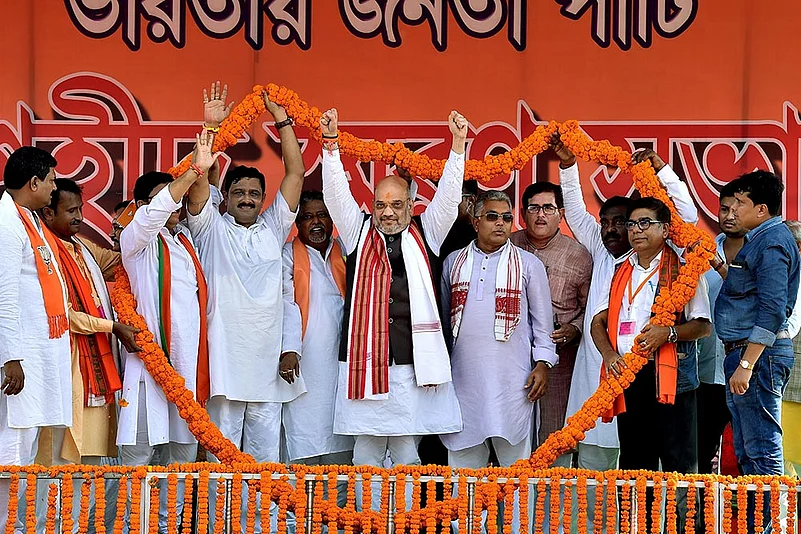The BJP’s brute, clean majority in the parliamentary elections of 2014 was achieved without much success in West Bengal—it won only two of the state’s 42 seats. So, when BJP president Amit Shah trumpeted at a public rally during a recent visit to the state that the party would gain over 20 seats in 2019 and win at least 22, it raised eyebrows and curled lips.
Read Also: 2019 Lok Sabha Election: The Vizier’s Gambit
But some believe that Shah does indeed have a foolproof pre-election strategy—something known to swing the most resistant of electorates towards the BJP. “Shah is focusing on strengthening the organisation at the grassroots, which has been the BJP’s weakest point in these states,” says political commentator Tarun Ganguly. A BJP insider confirmed this, “Workers are being sent door to door to win the confidence of voters,” he tells Outlook.
“For the BJP in Bengal, leadership is not the issue. What was lacking was ground strength…. We are going all out to address the lacuna. This is the only way to take on the ruling party,” says BJP leader Chandra Kumar Bose.
Like the Left Front in the past, the Trinamool Congress is known for its total control over ground politics, and is prepared to go to any length to defend its overwhelming supremacy. The cycles of violence over the panchayat polls are testimony to that. “Chief Minister Mamata Banerjee has a tight grip on the ground,” psephologist Biswanath Chakraborty tells Outlook. “She built this up by focusing attention on the grassroots, sending out cadres to convince people to vote for Trinamool, and she herself covered the state before the 2011 assembly polls.”
Amit Shah, claim BJP sources, has held over a dozen meetings with leaders and ground workers to chalk out plans of a similar ground assault in Bengal. However, the reality for Mamata in 2011 was vastly different—the congealed anti-incumbency against the Left Front government had gained critical mass and finally breached their bastion, with Mamata offering a viable alternative and drawing away both voters and party workers.
With the Trinamool still having a free run of all political spaces in every corner of Bengal—mind you, Mamata was re-elected in 2016 with a larger majority—the BJP will have to fight for every inch of the turf. The other disadvantage for the BJP here is that it has little hope of commanding the crucial Muslim vote. “In Bengal, parties have traditionally depended on consolidating the Muslim vote—27 per cent of the population. And Muslims by and large vote as a community,” says Ganguly. To this may be added Mamata’s persistent, populist wooing of them—like various public distribution schemes for Muslims and a monthly stipend of Rs 2,500 for Imams. Indeed, the cry of ‘minority appeasement’ that accompanies such measures is the one vital political issue for the BJP to exploit in Bengal.
Shah’s exuding confidence in the teeth of such patent difficulties indicates that there is more to his strategy. Sources say that Shah initiated Bengal-specific tactics during his last visit, including consolidating the Hindu vote. “Hindus in Bengal have never voted on religious lines; our brief is to ignite the feelings of Hindutva,” says a BJP source. Therefore, Shah’s parting shots of “Jai Shri Ram” at the end of his rallies in Bengal baffled analysts, who thought the BJP would try to win Muslims over. “One key issue discussed was the formation of ‘an army’ of Internet workers who would send out messages through Whatsapp, Facebook and Twitter,” adds the source. With more Shah visits planned, is this cause for concern for the TMC?
Trinamool Rajya Sabha MP Derek O’Brien makes light of the BJP’s hopes. “Let’s not build castles in the air. BJP has only three members in the state assembly, flopping in every bypoll. Its claims of rising voteshares do not reflect in seats won.” On a strategy the TMC might use to counter the BJP, O’Brien says, “Mamata Banerjee is focused on the two D’s—development and diversity, and that endears her to people. Which party will come a distant second or third is not our concern”.
By Dola Mitra in Calcutta
















